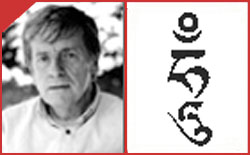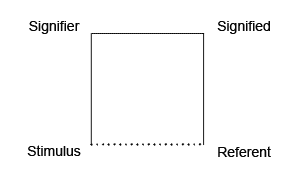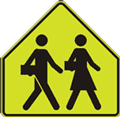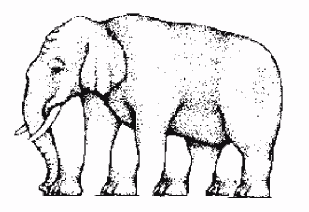Available Languages
- Consultez cette page en FRANÇAIS
- Consult this page in ENGLISH
Sign structures. The sign according to Klinkenberg
1. Abstract
Klinkenberg

There are numerous ways of defining the sign. The constitutive approach is a common one, in which a sign can be identified by the presence of specific terms and specific relations between the terms. We will be discussing just the terms. The main terms that enter into the definition of the sign are the following: (1) the stimulus (the physical signal being used, such as a vocal sound), (2) the signifier (the model, e.g., a phoneme, of which the stimulus is a manifestation), (3) the signified (the meaning or content of the sign), the concept (the mental representation of the signified), which is either (4) logical or (5) psychological, and (6) the referent (what we are talking about when we use a particular sign).
With these six terms, we can set up thirty-odd possible combinations, whether monadic (one term), dyadic (two terms), triadic (three terms), tetradic (four terms), pentadic (five terms) or sextadic (six terms). The most commonly used sign structures are the following: (1) the sign composed of the stimulus, (2) the sign composed of the signifier and the signified, (3) the sign composed of the stimulus or the signifier, the logical or the psychological concept, and the referent. To our knowledge, there is no sign structure composed of all six terms. However, there is at least one theory – Jean-Marie Klinkenberg's – that uses a tetradic sign. It is made up of the stimulus, the signifier, the signified and the referent. The structure of the iconic visual sign is slightly different; it includes a type (model) in place of the signified.
This text can be found in extended version in this book:
Louis Hébert, Dispositifs pour l'analyse des textes et des images, Limoges, Presses de l'Université de Limoges, 2007.
Click here to obtain the English translation of this book.
This text may be reproduced for non-commercial purposes, provided the complete reference is given:
Louis Hébert (2006), « Sign Structures. The Sign according to Klinkenberg », in Louis Hébert (dir.), Signo [online], Rimouski (Quebec), http://www.signosemio.com/klinkenberg/sign-structures.asp.
2. THEORY
In this chapter we will present an original and operational sign structure, giving particular attention to the iconic visual sign as defined by Klinkenberg (1996, 2000, 2001). For this purpose, we must introduce the four parts (terms) of this sign. Two additional terms will give us a total of six, which will allow us to study other sign structures as we proceed.
2.1 KINDS OF DEFINITIONS FOR THE SIGN
The sign has been defined in many ways, both functionally (what the sign does, what it produces) and by its constituents. With a constitutive approach, we say that a sign may be identified by the presence of its constituent elements. These elements are of two kinds: terms (or relata) and the relations between the terms. From one theory to another, the number of elements tends to vary, along with their names and their characteristics.
2.2 POSSIBLE PARTS OF THE SIGN
In this section we will focus on the terms, leaving aside the relations (such as semiosis, the relation of reciprocal presupposition between the signifier and the signified). We will compare some of the different ways of construing the sign's makeup with reference to the terms. For this purpose, we must introduce each of the basic terms that may be considered as part of the sign. But we will begin by defining the sign.
2.2.1 THE SIGN
The sign is the entity produced by combining one or more (depending on the particular theory) of the terms described below. Quotation marks are used to indicate a sign ("sign"). For example, if we write "tomato" in a text on semiotics, the quotation marks indicate that we are talking about the sign, not the thing itself, not the actual tomato.
2.2.2 THE STIMULUS
The stimulus (pl. "stimuli") is the perceptible physical element (e.g., a sound) that serves as the substrate in which the signifier is manifested. We use curly brackets to indicate the stimulus ({stimulus}).
2.2.3 THE SIGNIFIER
The signifier is the model (the type, in technical terms) of which the stimulus is a manifestation (a token, in technical terms). We indicate the signifier by using italics, e.g., boat is the signifier for the sign "boat".
2.2.3.1 DISTINGUISHING THE STIMULUS FROM THE SIGNIFIER
Verbal language has two kinds of signifiers: phonemes and graphemes. For instance, the phonemes [p] and [m] allow us to distinguish in English between the signs "pink" and "mink". The phonemes are associated with vocal sounds, which act as stimuli. Whether I roll the [r] in {Montreal} or not, my interlocutor will still understand that I am talking about the city in Quebec known as "Montreal". Likewise, if the red colour of a stop sign has faded to pink in the sun, I will still interpret the pink stimulus as the signifier red, which in the highway code conveys the idea of a required stop as its signified. The grapheme is to the graphic linguistic signifier as the phoneme is to the phonic linguistic signifier. So whether the {t} is crossed with a long or short line, whether it is typed in Times New Roman or Verdana, I can still understand that it is the grapheme t, despite the variations in the stimulus.
We will assume that the models of the sign that came after Saussure's (the renowned linguist from Geneva) are the only ones capable of distinguishing between stimulus and signifier. But not all do. Theories that predate Saussure or do not follow his approach do not include the signifier.
2.2.4 THE SIGNIFIED
The signified is the sign's meaning, its content. It is often broken down into semes, which are semantic features (indicated by forward slashes). For example, the signified that corresponds to the sign "crow" is the sum of semes such as /bird/, /black/, and so on. We indicate the signified by using apostrophes ('signified'), e.g., 'crow'.
2.2.5 THE CONCEPT
The concept is the mental representation corresponding to the signified. Along with the referent, this is the most problematic term to describe. It has been defined in numerous, sometimes contradictory, ways. Rastier (1991, pp. 125-126) identified six primary meanings for the word "concept". The concept is sometimes seen as a logical element, sometimes as a psychological element; sometimes as a universal or general element (one that shows no significant variation from one individual to another) and sometimes as an individual element. It seems that theories incorporating the logical concept as part of the sign do not incorporate the psychological concept, and vice versa.
2.2.5.1 DISTINGUISHING THE SIGNIFIED FROM THE CONCEPT
Some linguistic theories, including Rastier's interpretive semantics (1987, p. 25), distinguish between the signified and the concept (logical or psychological), whereas the classical theories tend to merge the two, even when they use the term "signified". The following is a definition that merges signified and concept: "The signified is that component of a Saussurian sign to which the signifier refers. It is a concept, abstracted from the intension (understanding) of the class of objects evoked by the signifier" (Mounin, 1982, p. 301). Greimas and Courtés hold the opposite view (1982, p. 48) – that Saussure treated the signified as a concept only "in a first approximation", a notion he subsequently eliminated in favour of his "signifying form".
The following is an example that illustrates why it is possible – if not necessary – to distinguish between signified and concept. Someone who is blind from birth is capable of understanding the linguistic meaning of "white". For instance, he knows that it is the opposite of "black" and he understands the meaning of "white cane" perfectly, even though the mental image or representation he has of white is no doubt different from that of a seeing person.
2.2.6 THE REFERENT
To go straight to the heart of a complex and difficult issue, the referent is what we are talking about when we use a particular sign. (For details, see the chapter on Jakobson, and also Hébert, 2001, chapter 1 and Hébert, 1998.) We use capital letters to indicate the referent (REFERENT). The referent can correspond to a concrete element (the CAT that is shown in a drawing of a cat) or an abstract element (LOVE, represented by the word "love"). It can correspond to a real element or a fictitious one (the UNICORN represented by the word "unicorn"). It can correspond to an entity (all of the examples we have given so far) or a process (the action EAT evoked by the drawing on a road sign picturing a fork and a knife). Lastly, it can correspond to an individual (JESUS CHRIST, as designated by "Jesus Christ", or the specific FIR TREE designated by "that fir tree") or a class (FIR TREES as represented in a drawing of a forest).
2.3 A TERM'S STATUS
In any given theory, each of these terms has a status, as follows: either it is part of the sign, or it is not part of the sign (and may not even exist). For example, theories based on Saussure's do not include the referent as part of the sign. To give another example, Rastier says that the cognitive concept (which he calls the "mental image" or "multimodal simulacrum") is external to the sign, but related to it, with the signified determining or influencing the concept (Rastier, 1991, p. 211).
NOTE: THE THIRD STATUS
It is theoretically possible to have a third, intermediate status: the term could be external to the sign, but part of its surrounding environment. For instance, with a dyadic sign composed of a signifier and a signified (to be discussed later), we could hypothetically consider the referent as external, but closely associated, to the sign.
2.4 THE SEQUENCING OF THE TERMS
The order in which we have presented the terms of the sign is not random. Indeed, there are many theories that arrange the constituent terms of the sign into an ordered trajectory. Klinkenberg goes from the stimulus to the signifier, then to the signified, and from there to the referent. The term "referential trajectory" has been proposed elsewhere for this sequence of stages ending with the referent (see Hébert, 2001, chapter 1 and Hébert, 1998, which do not include the term "stimulus"; we are adding it here). Naturally, a trajectory cannot be called "referential" if it is part of a theory that excludes the referent, like Saussure's.
2.5 THE NUMBER OF KINDS OF POSSIBLE SIGNS
From a strictly mathematical standpoint, if we accept as terms the stimulus, the signifier, the signified, the logical concept, the psychological concept and the referent, there are thirty-odd combinations of terms, and therefore thirty-odd possible sign structures. These structures can be monadic (one term), dyadic (two terms), triadic (three terms), tetradic (four terms) or pentadic (five terms). Even a sextadic model is possible, composed of six terms.
In practice, there are several models that are not attested, to our knowledge. For example, it would be hard to justify a theory claiming that the sign is made of the signified alone. And as far as we know, there is no theory that includes both the logical and the psychological (cognitive) concepts. Lastly, to our knowledge, there is no theory that uses a sextadic model.
2.6 EXAMPLES OF POSSIBLE SIGNS
In this section, we will briefly describe some of the primary combinations attested in various theories.
2.6.1 THE MONADIC SIGN
The oldest theories of the sign are called nomenclatural: a different stimulus designates each different thing. There are also neo-nomenclatural theories, such as the theories of Morris (1938, 1946), Carnap (1975), Montague (1974) and Russell (1903) (restricted to logically proper names).
NOTE: NOMENCLATURAL THEORIES AND THE DYADIC SIGN
It is also possible to construe nomenclatural theories as dyadic, if we think of the designated thing as a referent, and as being part of the sign; then a different stimulus designates each different referent.
2.6.2 THE DYADIC SIGN
At the beginning of the 20th century, Ferdinand de Saussure advanced the notion of a dyadic sign, composed of the signifier and the signified; it is often pictured as a circle with the signifier in the lower half and the signified in the upper half. Greimas and Rastier – whose theories are presented in other chapters – view the sign as being fashioned along these lines.
2.6.3 TRIADIC SIGNS
There are numerous theories of the triadic sign. A triangle is often used to visually represent this type of sign, known as the "semiotic triangle". The base of the triangle is usually shown as a dotted line, indicating that the relation between the first and last points is less direct than the others. We will come back to this.
The following diagram is based on a diagram by Umberto Eco, enhanced with some additions (mostly from Rastier, 1990). It matches up various names given to the "same" terms. We have put "same" in quotation marks, because these terms are often interpreted in very different ways. They are actually more analogous than equivalent. For instance, Peirce's "interpretant" is the term in his theory of the sign that comes the closest to what Saussure calls the "signified" and what Aristotle calls "states of mind", and so on. In order to give reference points, we have placed Saussure's terms for the sign in the diagram, but we should point out that the Saussurian sign is not triadic; it is dyadic, as we have just seen.
The terms of the semiotic triangle
• signified (Saussure) |
|
|
|
• signifier (Saussure) |
• referent (Ogden-Richards) |
NOTES: TERMINOLOGY ; PROFUSION AND CONFUSION
Here is a comment from Eco (trans. of 1988, page 39) on the profusion of terminology around the semiotic triangle: "One person even goes so far as to use the term 'signified' for what we call the referent and 'meaning' for what we call the 'signified'. And for example, Frege's Bedeutung was translated as 'signifié' or 'meaning' by one person and as 'reference' by another." Divergent terminologies sometimes obscure theoretical agreement; sometimes they reinforce and highlight profound disagreements. Sometimes the same name is used for different terms. This is the case with the signified, which in practice is often construed as a concept, in direct contradiction, as we have seen, with Saussure, who invented the name.
The most common triadic sign structures combine the stimulus or signifier, the logical or psychological concept, and the referent. For instance, we would say that the Aristotelian sign is composed of a stimulus, a psychological concept (state of mind) and a referent. Many of the theories that use this sign have used the term "signified" for what is in fact a concept.
2.6.4 THE TETRADIC SIGN
Since to our knowledge no one has proposed a sign composed of either five of our terms or all six, we will finish our presentation of sign structures with the tetradic sign. The only tetradic sign we know of that incorporates four of the terms we have presented is Klinkenberg's (1996). According to Klinkenberg, the sign is composed of the stimulus (it was from his work that we adopted the name of this term), the signifier, the signified and the referent. (The iconic visual sign has a slightly different structure, as we will see.) This tetradic model is represented visually as a rectangle, shown below.
Visual representation of Klinkenberg's tetradic sign

NOTE: WHY THE DOTTED LINE BETWEEN THE STIMULUS AND THE REFERENT?
The dotted line between the stimulus and the referent indicates that the relation between them is not as direct as the relations between the other terms of the sign. The relation between the two terms is arbitrary, in fact. The stimulus {apple} is no more appropriate for designating an APPLE than any other combination of vocal sounds. For evidence, we have a different stimulus, {pomme}, associated with the same referent in French. But non-arbitrary signs do exist (we say they are motivated), like the iconic visual signs that we will discuss below.
2.7 THE ICONIC VISUAL SIGN ACCORDING TO KLINKENBERG
According to Klinkenberg (2000), the iconic visual sign (the sign associated with the figures shown in an image) is different in structure from other signs, especially the plastic visual sign (the sign associated with the colour and texture of the paint paste, for example). The signified is replaced with the term "type":
"The 'type' has a specific function that we will understand by looking at the structure of the iconic sign [e.g., a drawing of a cat]. The stimulus – that is, the physical medium of the sign (e.g., shading, lines, curves) – has a transformational relation with the referent (the class of animals called cats): the cat-drawing is nowhere near identical to the cat-animal. But I recognize a cat because the stimulus matches a model (the signifier) that is equivalent to a type (a set of visual attributes) which in turn matches what I know about the cat-animal (the referent). All of this may seem complicated, but it allows us to see that for an iconic sign, the process of signification works because the stimulus (the drawing) and the referent (the thing represented) are in conformity with a single 'type' charged with the transformations that operate between the stimulus and the referent" (trans. of Klinkenberg, 2001, p. 111).
3. APPLICATION: THE EXPLANATION BY MAGRITTE
* * *
The Explanation
Magritte (1952)

© Estate of René Magritte / ADAGP (Paris) / SODRAC (Montréal) 2005
* * *
In this section, we will present a short analysis of the terms of Klinkenberg's sign as found in a painting by Magritte entitled The Explanation. The painting contains the following iconic figures: the carrot, the bottle, the carrot-bottle, the flat surface on which the three figures are set, the mountains and the cloudy sky. We will talk about the carrot, although the same reasoning will apply to the other iconic figures, with some adjustments for the carrot-bottle. The paint strokes of the irregular, conical, striated orange shape with a foliage top form the stimulus for the signifier associated with the signified 'carrot'. The referent associated with these three terms of the sign is the real-world object that has similar properties to those of the stimulus.
The properties are similar, but not identical, because there is a transformation operating between the referent and the stimulus, as with any visual iconic sign. For example, the referent (a real carrot) is three-dimensional; the stimulus (the carrot pictured) is two-dimensional, although an artificial three-dimensional effect has been created in the painting. Still, the transformations would have been more substantial if the painting's technique had not been altogether realistic (and they would have been less if the carrot had been painted in trompe-l'oeil). Obviously, the realism of this surrealistic painting is breached. This is done in two ways: Firstly, the carrot-bottle object does not exist in reality, and unlike the unicorn, for instance, it is not a stereotyped object that appears in many other semiotic acts (texts, paintings, and so on). This object is peculiar to Magritte. That does not make it any less a referent: this-here object is what the sign is talking about. Secondly, the objects in the foreground, which are small, mundane domestic objects associated with humans (the carrot and the wine are both intended for human consumption), are forcibly plastered onto a wild and poetic majestic natural background. In both cases, Magritte takes simple, well-known elements and combines them surrealistically. The first combination – the carrot and the bottle merging – is so overt that it constitutes the "explanation" of the way Magritte composes his strange paintings.
4. LIST OF WORKS CITED
- ARNAULD and NICOLE, La logique ou l'art de penser, Paris: Flammarion, (1970) [1683].
- CARNAP, R., Meaning and Necessity, Cambridge, MA: Harvard University Press, 1975.
- ECO, U., Le signe, Brussels: Labor, 1988.
- GREIMAS, A. J. and J. COURTÉS, Semiotics and Language: An Analytical Dictionary, Bloomington: Indiana University Press, 1982.
- HÉBERT, L., "Référence du référent", Semiotica, Bloomington: International Association for Semiotic Studies, 1998, 120-1/2, pp. 93-108.
- HÉBERT, L., Introduction à la sémantique des textes, Paris: Honoré Champion, 2001.
- KLINKENBERG, J.-M., "Le sens et sa description", Précis de sémiotique générale, Paris: Seuil, 1996, pp. 92-100.
- KLINKENBERG, J.-M., "Structure des signes iconiques", Précis de sémiotique générale, Paris: Seuil, 2000, pp. 382-394.
- KLINKENBERG, J.-M., "Qu’est-ce que le signe ?", in J.-F. Dortier (dir.), Le langage, Auxerre (France): Sciences humaines, 2001 pp. 105-112.
- MONTAGUE, R., Formal Philosophy, New Haven, CT: Yale University Press, 1974.
- MORRIS, C., Foundations of the Theory of Signs, Chicago: Chicago University Press, 1938.
- MORRIS, C., Signs, Language and Behavior, New York: Prentice Hall, 1946.
- MOUNIN, G. (dir.), Dictionnaire de la linguistique, Paris: Presses Universitaires de France, 1993 [1974].
- OGDEN, C. K. and I. A. RICHARDS, The Meaning of Meaning, London: Routledge and Kegan Paul, 1923.
- RASTIER, F., Sémantique interprétative, Paris: Presses Universitaires de France, 1987.
- RASTIER, F., "La triade sémiotique, le trivium, et la sémantique linguistique", Nouveaux actes sémiotiques, 1990, v. 9, 55 p.
- RASTIER, F., Sémantique et recherches cognitives, Paris: Presses Universitaires de France, 1991.
- RUSSELL, B., Principles of Mathematics, Cambridge: At the University Press, 1903.
- CARNAP, R., Meaning and Necessity, Cambridge, MA: Harvard University Press, 1975.
5. EXERCISES
A. Analyze the terms of the iconic visual signs in this street sign indicating the beginning of a school zone. You need to know that cautionary road signs are usually yellow, at least in Québec.

B. The stimulus in this image is the result of what transformations of the referent?



